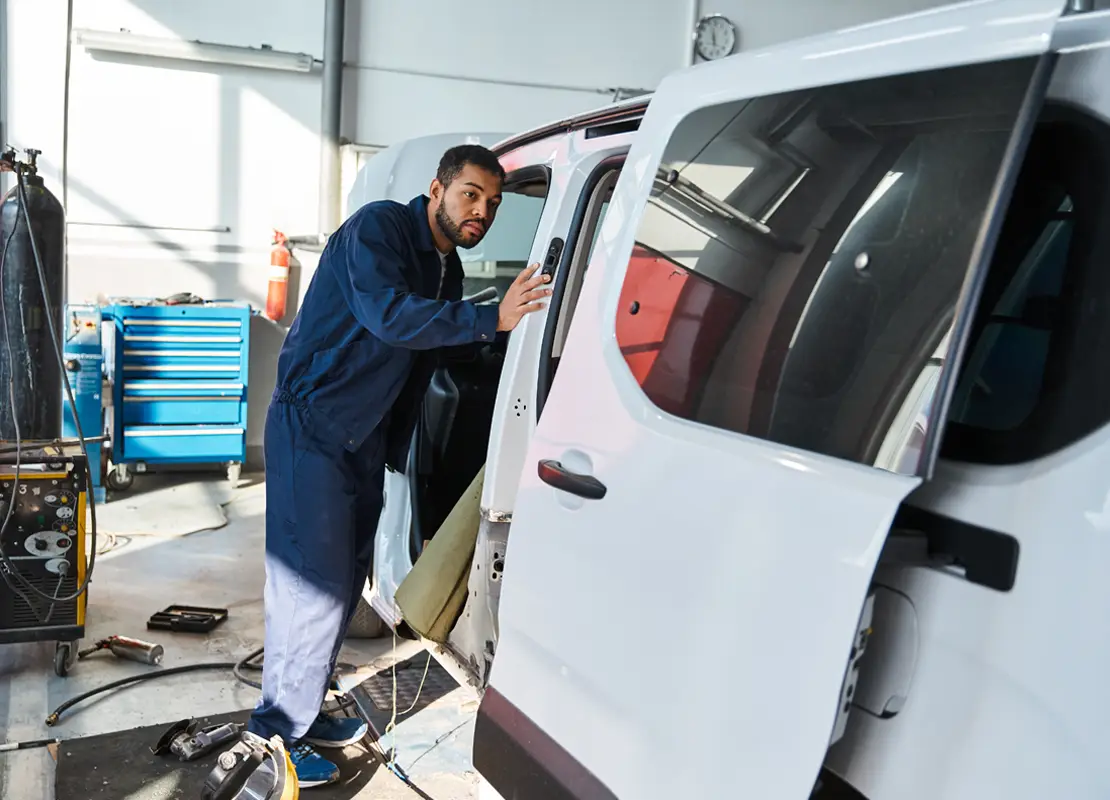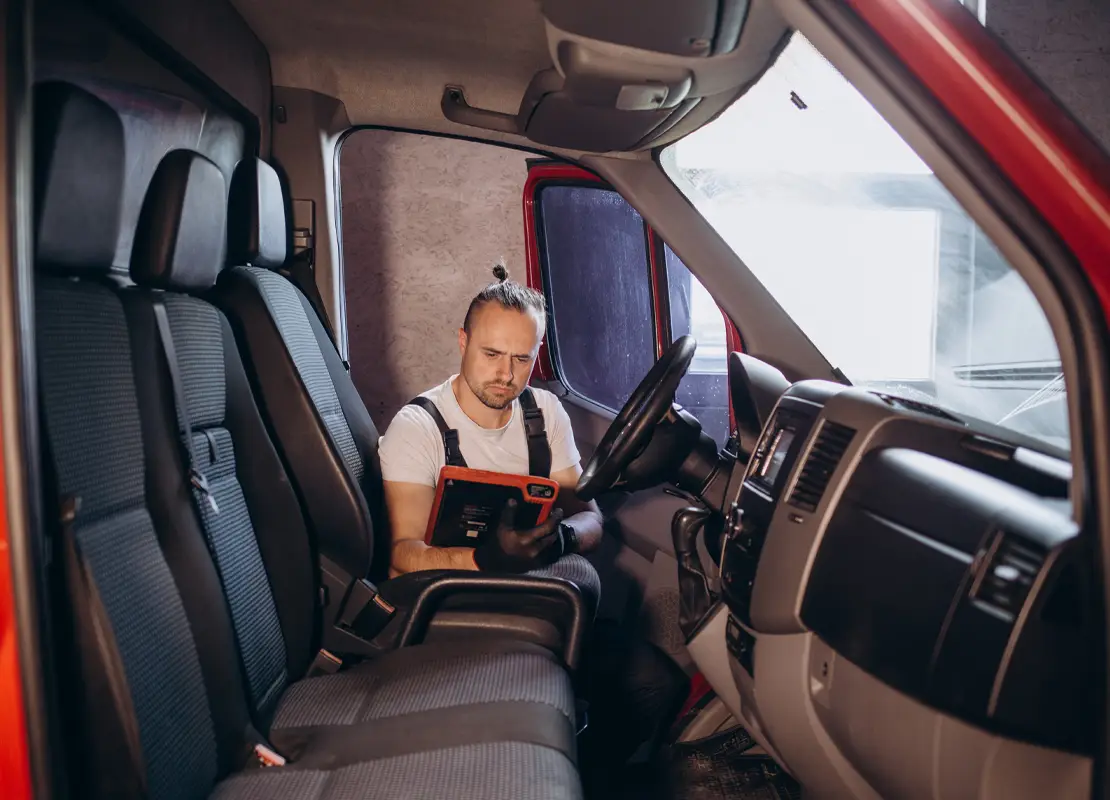
Chat with us
Our specialist team are available to help
Under the terms of your van leasing agreement, a vehicle must be returned in an acceptable condition or be subject to end-of-lease charges if its equipment or accessories are not used, maintained or looked after as originally stipulated at the start of the lease.
However, you can avoid additional costs caused outside the acceptable terms of ‘fair wear and tear’ by looking after your commercial vehicle carefully.
Should you contact us with any queries you may have regarding wear and tear. We can assist you in making sure your van lease is smooth and hassle-free from the moment you enquire to the moment you return the vehicle.

It is understood that commercial vehicles are working vehicles and, as such, some areas such as working surfaces/loading areas will be subject to a higher reference level of fair wear and tear.
The condition of a ‘working’ vehicle must specifically allow for wear and tear appropriate to their operation and use.
However, it is important to understand that wear and tear should not be confused with damage.
Damage to a vehicle occurs as a result of a specific event or series of events such as impact, inappropriate stowing of items, harsh-treatment, negligent acts or omissions.
No, you will not be charged at the end of the lease for any refurbishment that arises from normal wear and tear in line with the vehicle’s use and its age.
A thorough inspection of the vehicle will be carried out by an independent company using fair wear and tear guidelines to determine whether any areas do not conform to the terms set out in the leasing agreement.


You could be liable for end of lease charges if your vehicle is judged to have sustained damage outside of the fair wear and tear policy or is missing a key component (eg. service history or keys).
The charges compensate for the cost of rectifying damage or replacing missing equipment before the vehicle is sold.
Vehicles which cannot be legally driven on a public highway, any engine seizure or damage due to insufficient coolant, oil or broken internal components. A noisy or damaged clutch or gearbox. The vehicle’s engine management system should not be displaying any warning light.
Missing or unstamped service books; vehicles not serviced to manufacturer’s schedule; no current MOT certificate where applicable
Unsecure and leaking, scratching and/or isolated stone chips. Damaged heating element, cracks or holes
Missing, cracked or damaged mirror casings
Damage to the sidewall or tread; tyres that do not meet manufacturer’s recommendations of type, size and speed rating; uneven wear. Less than 1.6mm depth throughout a continuous band in the centre three-quarters of the tread and around the entire circumference
Any spoke or hub damage to the wheel (steel or alloy). Damaged or missing spare wheel (or missing emergency tyre inflation kit including the compressor and canister), jack and other related tools.
Flaking paint, preparation marks, paint contamination, rippled finish, mismatched or off-colour paint, poor panel fitment or any other evidence of poor repairs.
Missing keys, including but not limited to, the master deadlock, slam lock keys (including spares), and locking wheel-nut keys. Damaged remote locking system (if applicable) or missing remote controls
Remaining decals, labels and advertising to the bodywork or glass unless prior agreement has been made by us. Any damage caused by their attachment or removal should be made good. This includes glue residue and faded paintwork.
Missing vehicle documentation (including the operation manual). Audio equipment security codes and any other documents relating to vehicle equipment. Any odometer alterations must be reported. Unauthorised odometer changes are unacceptable
Damaged or malfunctioning equipment (eg. Bluetooth, satellite navigation or any other integrated system). CD and media systems with damaged or missing facias and speakers. Any missing original equipment items, such as parcel shelves, tonneau covers, satellite navigation discs/SD cards and charging leads.
Damaged, unapproved or non-operational lights, lamps, reflectors and beacon lights. Holes or cracks are not acceptable
Damaged or missing accessories as provided with the vehicle at the commencement of the lease, such as tool kits, towing pins, roof racks, first aid kits and fire extinguishers.
Excessive scratches to the paintwork on roller shutters. Damage caused by impact or movement of the load. Cracks, holes and other damage
Damaged or distorted platforms and runners. Expired/invalid statutory certificates
Distortion to the roof, panel or gutter rail
Poor condition (eg. Rust) without working electrical connections. If the tow bar is removed then you are responsible for repairing.
Commercial vehicles are regarded as ‘working vehicles’ and their condition at the end of contract must specifically allow for wear and tear appropriate to their operation and use.
Exterior paintwork, body, bumpers and trim are all permitted only light wear and tear. Paintwork must be intact and with no deviation to the original shape of the vehicle.
In areas with surfaces and components that come in direct contact with transported loads – such as a flat bed or cargo bay - heavier wear and tear is acceptable, such as scratches, chips and small dents. However, there must be no deviation to the original shape of the vehicle.


The interior upholstery, facia, headlining and trim must be clean and odourless with no burns, scratches, and tears or staining. Floor coverings and surrounding trims should not be torn or split.
Carpets and footwells should not have holes. Wear and soiling through normal use is acceptable. Interior fittings such as seat belts, rear view mirrors, courtesy lights, sun visors, doors bins etc, must be present, intact and free of damage. All accessories (e.g. first aid kits, fire extinguishers) must be returned intact or replaced with items of similar standard and specification
There are several ways of ensuring your vehicle isn’t subject to additional charges when it comes to returning it.
You can avoid additional costs caused outside the acceptable terms of ‘fair wear and tear’ by looking after your vehicle carefully during the period of your lease agreement.
This can be achieved by maintaining a full-service history and adhering to the servicing interval checkpoints as recommended by the manufacturer.
It is also encouraged that any damage or excess wear is identified and fixed in a timely manner to ensure any ongoing issues don’t become worse and/or irreversible. This is particularly important of paintwork damage.
Alternatively, you can invest in a Maintenance Pack, which is built into the cost of your monthly van leasing payments. This provides peace of mind that any unforeseen vehicle repairs are carried out efficiently and professionally without necessitating a large capital payment.

If you are coming up towards the end of your lease agreement and are aware of damage and imperfections beyond the terms of ‘fair wear and tear’, it would be prudent to consider carrying out repairs and maintenance well before it undergoes an inspection upon its return to the broker.
It is recommended that you:
We offer the best van leasing deals to give you an affordable and hassle-free way into driving a new van at unbeatable prices.
With a huge range of high-quality vans from leading manufacturers to choose from, there is something for everyone at Vansdirect.
With our expert impartial advice and helpful van reviews, plus a range of benefits with your van when lease from Vansdirect – including three-year manufacturer warranties, free UK delivery and a free driver pack to get you started – you’ll .
Call now to speak with our specialist team about a van lease with Vansdirect so you can get the right van, the right deal, right now.